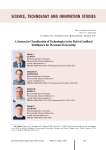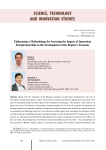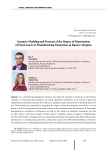Science, technology and innovation studies. Рубрика в журнале - Economic and Social Changes: Facts, Trends, Forecast

Статья научная
The development of the Russian economy, including through large-scale introduction of digital technology and artificial intelligence technology, requires appropriate resources. Qualified personnel is one of them. The need for trained specialists poses important questions to state institutions - whom to train and in what quantity; this, in turn, demands a detailed elaboration on the issue of staffing requirement. The article presents the results of development of a classification system of artificial intelligence technology for solving personnel forecasting problems. Theoretical significance of the research findings consists in the creation of a classification system that structures existing knowledge about technologies in the field of artificial intelligence and has the potential to gain new knowledge. The novelty of the approach to the classification of artificial intelligence technologies consists in using a three-component structure of technologies “methods tools - application areas” and adjusting the classification to suit the tasks of forecasting the demand of the economy for personnel with competencies in the field of artificial intelligence. The classification is based on the results of analysis of scientific publications on AI (journals of the first quartile Q1 and conferences of the A/A* level). “The Systematic Literature Review” method was used for their research. All thematic publications indexed in Scopus were also analyzed. Practical significance of the results is revealed in relation to the tasks of personnel forecasting in the field of artificial intelligence. The developed classification makes it possible to structure the personnel need at different levels of refinement of artificial intelligence technologies. Another direction in the development of the proposed classification is to compare competencies (knowledge, skills and practical experience) in popular groups of professions with components of artificial intelligence technologies (methods, tools, applications) to design educational programs in the relevant field. The proposed classification has the potential for development: one of the ways is an expert assessment of priority areas for the development of artificial intelligence. The article presents an overview of the results of application of the classification.
Бесплатно

Статья научная
Along with the transition of the Russian economy to innovation development, the role of innovation entrepreneurship as a driver of intensive economic growth has significantly increased. This type of entrepreneurship provides regions with competitive advantages. The purpose of the study is to assess the extent of influence of innovation entrepreneurship on the level of economic development of Russian regions by testing the technique of regression analysis of panel data. In order to achieve this goal, we addressed the following tasks: first, we reviewed scientific papers that investigate the influence of the innovation factor (including innovation entrepreneurship) on the development of the regional economy; second, we selected and scientifically substantiated the choice of statistical indicators that reflect, on the one hand, the development of innovation entrepreneurship and on the other - the development of the economy of Russian regions; third, we analyzed the impact of innovation entrepreneurship on the economic development of Russian regions on the basis of the indicators selected and with the use of econometric tools. We applied the following scientific methods: systematization, generalization, study of literature, documents, and results of activities. We should separately highlight the method of mathematical modeling that we used to perform a regression analysis. The following results were obtained: first, on the basis of the review, we found that innovation entrepreneurship has a significant impact on the development of the economy of regions, especially during recession periods; second, the results of the regression analysis allowed us to confirm the hypothesis that innovation entrepreneurship should be considered a significant factor in economic development of Russian regions. We also revealed that in the conditions of the modern domestic economy, the technological component of innovation entrepreneurship (the essence of which is the development of innovative solutions) is the most prominent one.
Бесплатно

Статья научная
In a deteriorating geopolitical situation and under the pressure of sanctions on the Russian economy, its manufacturing enterprises are facing significant restrictions in the import of high-tech equipment and materials necessary for technical re-equipment and modernization of the fixed assets they use. These restrictions contribute to increasing the degree of their deterioration and will do so in the future as well. The hypothesis of our study consists in the assumption that the dynamics of fixed assets depreciation at enterprises is influenced not only by the volume of attracted investments, but also by other factors, and that the degree of their impact in different groups of regions is differentiated. The aim of the work is to design forecast scenarios that would show the changes in the degree of fixed assets depreciation at manufacturing enterprises, taking into account the differentiated influence of factors. The study presents a methodological approach based on statistical and regression analysis using panel data and autoregressive integrated moving average (ARIMA) model to identify factors affecting the dynamics of fixed assets depreciation at manufacturing enterprises in various regions and design a system of forecast scenarios for its changes in the future. We group the regions according to the degree of depreciation of fixed assets of manufacturing enterprises (we identify groups of regions with an extremely high level of fixed assets depreciation, and the levels above and below the Russian average). Using regression models we identify the differentiated influence of factors on the dynamics of fixed assets depreciation: in the first and third groups of regions, the key factor in increasing depreciation is the difficult financial situation of enterprises; in the second group - insufficient volume of attracted investments in fixed assets. For each group of regions, autoregressive modeling of the dynamics of these factors is carried out using a moving average to form the most likely forecast scenarios for changes in the degree of fixed assets depreciation at manufacturing enterprises until 2024. As a result of forecasting, we identify regions with the most likely dynamics of further increase in the degree of depreciation of fixed assets of enterprises; these regions should become a priority in obtaining state support for the implementation of industrial policy in Russia.
Бесплатно

